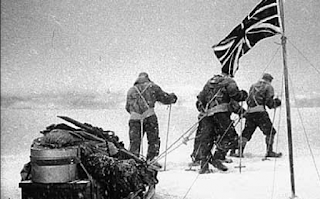The book.
The basic premiss of the story is that an atheist professor by the name of Richard Dawkins is on his way to Upper Bottom (cue some very subtle but rather impolite wordplay here) to address the Women's Institute, when he gets stuck in the snow and has to find temporary accommodation with a retired Anglican vicar called Potter.
We see therefore the development of several dramatic themes, which make this one of 2014's great tragic novels about the sorrows of a senior academic in good standing. Even When Tina Beattie was taken to a Latin Mass and When Hans Küng was given a papal encyclical for his birthday cannot compare with the book's atmosphere of sheer misery.
Professors are tragic people.
As a close friend of the Regius Professor of Rocket Science, New Testament Greek, and Human Flourishing, I know that professors are, by and large, deeply tragic people. Especially science professors, who may be extremely brainy about things like genes and memes, but may not have much of a clue about real life. (Of course there are many exceptions.)
So our hero Professor Dawkins - often confused with the man in the wheelchair - is cast as an innocent creature, one who will face the vicissitudes of Fate while raging blindly against the world.
Professor Dawkins heads for Upper Bottom.
On his journey, Dawkins has many adventures, but it's bad form to include too many spoilers, so I will be a little vague here. However, I can reveal that he is called in to save a cat having difficulty with childbirth. Will he earn headlines such as "GODLESS BUT CARING ACADEMIC BRAVES SNOW TO DELIVER KITTENS" or will he be too late, and have to settle for "ATHEIST VISITS DEAD CAT"? Will he deliver the kittens, or be forced to euthanase the mother, perhaps by feeding her into a large antique mangle (for want of any more convenient device)? You'll have to read Chapter 14 to find out.
The professor meets many challenges to his faith - or lack of it - on the way. We have all wondered why, if Charles Dickens's theory of evolution is correct, there are no hairy fishes flapping around the water's edge. Dawkins can answer this question, and in fact gets very tired of answering it.
His rival, A.C. Grayling - better hair, but he hasn't done the experiments.
After a series of adventures, often involving unconventional means of transport, Dawkins does indeed reach Upper Bottom, just as Scott did eventually reach the South Pole. However, his non-faith is severely questioned on the way. Sometimes he is 6.9 out of 7 sure that there is no God, but at other times he weakens, and it is only 6.8 - a significant difference.
As for what happens next... well read it yourselves. I enjoyed the book very much - even the rude bits.





I don't want to spoil the book either, but is this is the one where he has his 'Road to Upper Bottom moment," and gets converted by JC? JC was out in the cold too (or was it thin ice?) at the time, what with the National Anthem and all that.
ReplyDeleteInteresting to know he's out of the wheelchair now, that's JC for you (who needs the NHS). Upper Bottom could be the new Lourdes
No, I think it's fair to say that Richard Dawkins remains mostly unsaved at the end of the book.
Delete